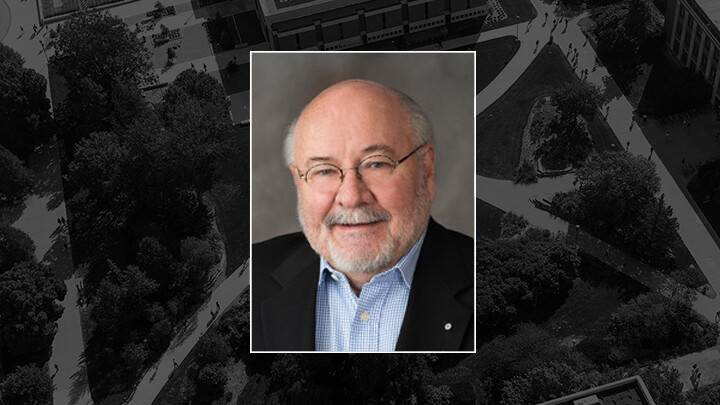
W. Cecil Steward, 87, emeritus dean and emeritus professor of architecture, died Nov. 2.
Steward is the first dean of the University of Nebraska–Lincoln’s College of Architecture. At the time of his appointment in 1973, he was the youngest dean of architecture in the nation. He served in the role for more than 27 years, retiring in 2000.
“Cecil Steward was a legend,” said Katherine Ankerson, current dean of architecture. “The College of Architecture stands on the shoulders of giants and leaders such as Cecil. We would not be the institution we are today, if not for his vision, passion and stewardship of this great college.
“Thanks to his generosity and kindness, thousands of dollars in scholarships over the years have been awarded to our students, always having their future foremost on his mind. I can’t express how deeply this loss will be felt not only among our college family but also the profession as he made such an indelible impact on its history and trajectory. He will be greatly missed by so many.”
Steward was among the driving forces that saved the university’s Architecture Hall from a planned demolition in the 1980s. The work subsequently led to the building’s $4.4 million expansion and remodel in 1987.
At the institutional level, Steward led the conversion of the university’s architecture program into a six-year, professional status program; added a public service center for community development; transferred the interior design degree to the College of Architecture; secured departmental status for the Interior Design and Community and Regional Planning programs; and created the Hyde Programs for visiting scholars and lectures.
He was well respected throughout the allied professions for his numerous contributions in educational outreach, the elevation of professional standards and his passion for sustainability.
Steward said the accomplishments he was most proud of included implementing the requirement of continuing education for architects as part of an American Institute of Architects policy that he led the charge on as AIA president; participating in the first architectural education delegation that established China’s first legal framework for the title “architect,” and the management of education and practice of architecture; leading the creation of the Nebraska Harry F. Cunningham Gold Medal; establishing the Nebraska Center for Sustainable Construction; and creating a non-profit entity, the Joslyn Castle Institute for Sustainable Communities, to bring sustainable development principles into the education and practice of architecture and planning.
Fellow board member and colleague Sharon B. Kuska, professor of architecture, remembers his passion and what a remarkable career and life he led.
“It’s hard to put into words that will do justice to what my mentor, my colleague, and my dear friend, Cecil Steward meant to me and the profession,” Kuska said. “He was a wise and trusted counselor and teacher, loyal to the architectural profession and to the academy; he shared his experience and insight, dedicated to educating and envisioning; he expressed passion and ingenuity, committed to sustainability and design. Cecil was a true idealist with a creative intellect that at times bordered on quixotic. He lived each day with purpose, and lucky for us, shared his work, his dreams, and his vision with the world.”
Steward earned numerous awards and accomplishments throughout his lifetime including the Joint Award for Excellence in Architecture Education; the Topaz Medallion by the AIA and the Association of Collegiate Schools of Architecture with the title, Distinguished Professor, ACSA/AIA; W. Cecil Steward Distinguished Chair for Sustainable Design, founding recipient, University of Nebraska Foundation; Outstanding Educator of the Year, University of Nebraska-Lincoln; and the first living recipient of the AIA Nebraska’s Harry F. Cunningham Gold Medal for Architecture.
Known as a transformative leader, Steward influenced and molded the design and planning professions by serving on boards and committees such as the United Nations Best Practices for Sustainable Development and Local Leadership Program, the Nebraska Capitol Environs Commission, the UN Habitat steering committee for the creation of the World Urban Campaign and the Lincoln-Lancaster County Planning Commission, to name a few.
“Cecil was a personal friend, a most distinguished university colleague and a giant in his field,” Chancellor Ronnie Green said. “His reach was extraordinary and extended from the university broadly across Nebraska, throughout our country and, indeed, the world.”
Steward’s board service included the Joslyn Institute for Sustainable Communities (JISC), the Architecture Research Centers Consortium, the Association of Collegiate Schools of Architecture, the National Architectural Accrediting Board (NAAB) and the American Institute of Architects. He was also elected president of the NAAB, the JISC and the national AIA.
Steward published more than 57 articles on sustainability in two years with the Lincoln Journal Star; coauthored with Kuska, the book “Sustainometrics: Measuring Sustainability” which has been translated to Chinese and published in China and the United States; and Steward with coauthor Kuska wrote a new manuscript, “Making Sense of Sensible Making: The Red Flag for Design,” which tracks design theory since the Industrial Revolution and makes the case for a new design theory for sustainable design.
“Beyond Nebraska and the university, Cecil was also a huge and dynamic force in the profession nationally, as well as a former president of the AIA. His support and mentorship - over many years — contributed tremendously to my own career,” said Roger Schluntz, professor and dean emeritus, School of Architecture and Planning at the University of New Mexico and vice chancellor of the AIA College of Fellows.
Steward’s family is planning on a private service.







